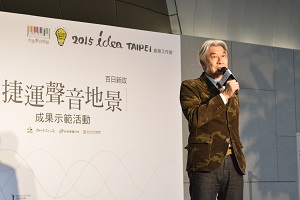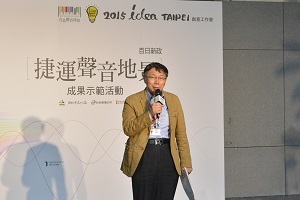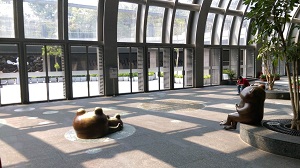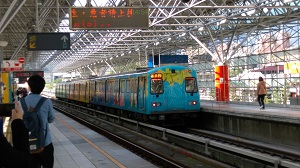Taipei plans to revolutionize metro sound system
By Yali Chen But what if the Taipei Rapid Transit Corporation took themselves seriously as metro stations not just for transport, but musical creation? In the first hundred days of Taipei City Mayor Ko Wen-je's tenure, the Department of Cultural Affairs has come up with a "soundscape" idea for the Mass Rapid Transport (MRT) system. The proposal was put forward by the creative workshop "idea TAIPEI," in which a total of 53 members participate, such as indie musicians, social psychologists, industrial designers, and Taipei residents. Several civil servants from the DCA (Department of Cultural Affairs), RDEC (Research, Development and Evaluation Commission of Taipei City Government), and TRTC (Taipei Rapid Transit Corporation) also took part in the project. This campaign aims to make the sound of the Taipei City subway a little lighter on the ears and benefit the subway's 2 million daily riders by replacing irritating beeps with more soothing chords as they swipe their metro card to catch a train. This is the dream of the DCA Commissioner Ni Chung-hwa, also known as the "Godfather of Taiwan's Pop Music" in the domestic music circles. Ni wants to reconfigure the soundtrack of the capital city's metro system, proposing to turn "cacophony into music" with a new suite of turnstile beeps. "I want to make every station in the capital city have a different set of dominant sounds," Ni said. "Thus, when Taipei commuters hop on a train and later get off at a certain station, they will hear a piece of music and be like, 'Oh that's the Daan Park Station.'" What a beautiful thought, the mayor Ko said, adding that he hopes each subway station would get its own jingle. At the press conference this past March 23, several special guests were in attendance to announce the soundscape proposal for the metro system, including Ko Wen-je, Ni Chung-hwa, the TRTC Chairman Ho-Chen Tan, and Zhou Li-min, Creative Director of Taipei Culture Foundation. The song Rain on Mido Avenue was sung in 1982 by Ouyang Fei-fei – a Taiwanese who has become one of the most popular resident foreign celebrities in Japan in the past half century. Ko added that hopefully in the future songs associated with the capital city will be played in the MRT system such as Sky of Taipei, Fork In The Road, and Drifting To Danshui because these songs instantly make subway riders relate to Taipei upon hearing them. The mayor also hopes that each subway station will have its own theme song created by the public. At the news event, the DCA staff demonstrated how to change the doors-closing sounds, alert sounds, and background music. In some cases, the alert sound for doors closing was turned into "ukulele festival," "Taiwanese folk music" and "frog croaks in nature" versions. Played on a Japanese samisen lute, Taiwanese folk song Four Seasons of Blossoming was demonstrated as a theme tune for the Beitou Station. A natural theme of humming insects and twittering birds, for example, would be played at the Daan Park Station to match the sounds heard nearby. In the near future, the doors-closing sound, alert sounds and background music may undergo changes. The Taipei Rapid Transit Corporation will celebrate its twentieth year of operation next year. Ni said that his department had discussed the soundtrack proposal with the TRTC staff. The plan is set to be executed by the end of this year and local commuters or foreign travelers will begin to hear different sounds at the metro stations. But some technical problems including broadcast equipment need to be solved, Ni added. In fact, Ni is not the first person to propose the "soundscape" idea. In Japan many train or subway stations have their own tune that is played just before a train pulls up or the doors of the train close. In some cases, the signature tune for the Maihama Station on the Keiyo Line is A Small Word because the stop is for Tokyo Disneyland. Travelers will also find the Chiba Lotte Marines (a Japanese professional baseball team) song playing at the Kaihin-Makuhari Station. One of the most well-known train lines in Japan is the Yamanote Line, a circular route operated by the JR East Japan Railway Company. The Yamanote Line was the first train in Japan to introduce electronic melodies at its stations. Of the 29 stations, 27 stops have a jingle, many of which are unique to just one station. It is said that each station has its own melody in an effort to help the blind navigate the Tokyo Metro independently. Meanwhile, if commuters are squashed like sardines in the rush-hour train or fall asleep on the train, they may miss station announcements. But the unique jingle of each station can help them to locate themselves. Subway riders and regular commuters by bus or train usually feel stressed, Ni said, adding that different melodies for the Taipei metro system can help them relax. James Murphy, front man of the now-defunct LCD Soundsystem, believes that New York's "underground music" scene leaves a lot to be desired. He wants to improve the underlying sound: the cacophony produced by the subway turnstiles. In 2014, Murphy launched a campaign to make the sound of the New York City subway a little lighter on the ears. He has worked out a unique set of notes for every station, one of which would sound each time a passenger swipes his or her metro card to catch a train. The busier a station becomes, the richer the harmonies would be. Each of the city's 468 subway stations would have note sets in different keys. Murphy's aural proposal aims to provide New York commuters with a more soothing urban environment; however, many New Yorkers are probably completely oblivious to the subway tones and their meaning. Murphy's subway-sound obsession began in the 1990s when he first rode the Tokyo metro and was blown away by the system's friendly voices and "incredibly gentle beeps." In his opinion, unique harmonic sequences could help cut down on riders missing their stops, boosting their emotional connections to their neighborhoods. Murphy hopes a softer sounding subway will make riders a little happier. It is also the DCA Commissioner Ni Chung-hwa's greatest wish that Taipei residents will show their support for a better-sounding subway.
STAFF WRITER There are so many different subway sounds: the whoosh and clatter of a train approaching, the beep of a turnstile, doors-closing sounds, alert sounds, and the whisper of people talking to each other. The living and non-living make a racket that occasionally coalesces into noise with shape and rhythm: the song of the Taipei City's bowels.
There are so many different subway sounds: the whoosh and clatter of a train approaching, the beep of a turnstile, doors-closing sounds, alert sounds, and the whisper of people talking to each other. The living and non-living make a racket that occasionally coalesces into noise with shape and rhythm: the song of the Taipei City's bowels. "Rain on Mido Avenue immediately comes to mind when I think of Osaka," Ko said.
"Rain on Mido Avenue immediately comes to mind when I think of Osaka," Ko said. A ride around the Yamanote Line will not only take travelers to visit many sightseeing spots in Tokyo, but also give them a great opportunity to listen to some of the distinctive train station melodies.
A ride around the Yamanote Line will not only take travelers to visit many sightseeing spots in Tokyo, but also give them a great opportunity to listen to some of the distinctive train station melodies. Even though Adam Lisberg, the Metropolitan Transit Authority spokesman, feels that Murphy's plan "is a very cool idea," Murphy is not the first person to propose the idea. Besides, it might be hard to put his idea into practice because any modification to the city's turnstiles would require too much risk, time and money. In fact, it probably means temporarily taking each of the city's 3,289 turnstiles out of service, something the authority is not inclined to do "for an art project."
Even though Adam Lisberg, the Metropolitan Transit Authority spokesman, feels that Murphy's plan "is a very cool idea," Murphy is not the first person to propose the idea. Besides, it might be hard to put his idea into practice because any modification to the city's turnstiles would require too much risk, time and money. In fact, it probably means temporarily taking each of the city's 3,289 turnstiles out of service, something the authority is not inclined to do "for an art project."

![Taiwan.gov.tw [ open a new window]](/images/egov.png)
